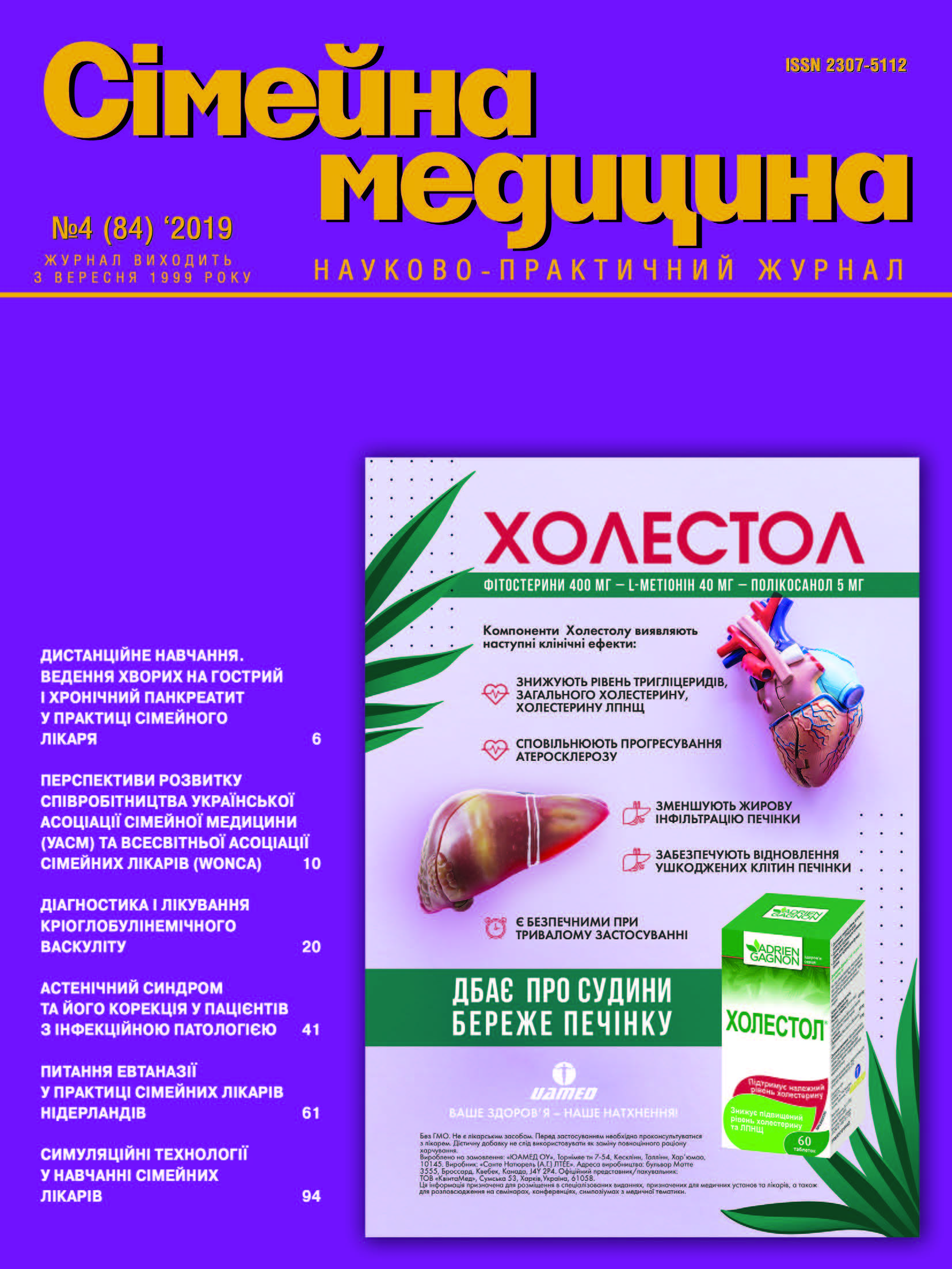Neuroimaging Characteristic of Structural Disorders of the Brain and Cerebrospinal Fluid Spaces in Patients with Chronic Cerebral Ischemia
##plugins.themes.bootstrap3.article.main##
Abstract
The objective: to evaluate the neuroimaging markers of structural disorders of the brain and cerebrospinal fluid spaces in patients with chronic cerebral ischemia (CHEM) on the background of multifocal atherosclerosis.
Materials and methods. The study enrolled 137 patients aged 40 to 84 years with chemotherapy with multifocal atherosclerosis. Patients were divided into three clinical groups depending on the localization of vascular pool lesions with stenosing atherosclerosis. Patients underwent qualitative and quantitative assessment of focal and diffuse changes in the substance of the brain and cerebrospinal fluid spaces.
Results. According to the frequency of detection among structural changes in the brain in patients with different variants of the combination of vascular pools affected by atherosclerosis, mild leukoaraiosis (61.3% from 97.1%) and mixed cerebral atrophy (74.5%) prevailed. Lacunar focal changes in CHEM were found in half of the cases (51.8%), including in the clinical group I in 36.7% of cases, in the second group in 56.3%, in the III group in 55.0 % Single lacunar foci in the general group of patients prevailed over numerous 2.7 times (37.9% versus 13.9%; p<0.001). More often, lacunar foci were territorially cortical (in 24.1% of cases) than subcortical (in 2.9% of cases; p <0.001). Most patients with CHM have found a combination of several MR markers of structural brain damage.
Conclusion. In patients of all age groups with chronic cerebral ischemia (CHEM), structural brain lesions were established based on the determination of various MR markers: white matter hypertension (leukoaraiosis – 97.1%), cerebral atrophy (74.4%), lacunar infarction (51, 8%), territorial postinfarction foci (56.2%). The multifocal nature of vascular lesion, comorbidity, and multifactoriality affect the heterogeneity and severity of structural brain disorders that determine the course of chemotherapy.##plugins.themes.bootstrap3.article.details##

This work is licensed under a Creative Commons Attribution 4.0 International License.
Authors retain the copyright and grant the journal the first publication of original scientific articles under the Creative Commons Attribution 4.0 International License, which allows others to distribute work with acknowledgment of authorship and first publication in this journal.
References
Маджидова Е.Н., Усманова Д.Д. Магнитно-резонансная томография при хронической ишемии мозга гипертонического и атеросклеротического генеза // Міжнародний неврологічний журнал. – 2014. – № 2 (64). – С. 46–51.
Кандыба Д.В. Дисциркуляторная энцефалопатия: гетерогенность развития хронической ишемии мозга, современные подходы к терапии // Российский семейный врач. – 2012. – Т. 16, № 3. – С. 4–13.
Smithuis R. Brain Ischemia – Vascular territories/ Radiology assistant. – November 24, 2008. – http://www.radiologyassistant.nl/en/p484b8328cb6b2
Van Norden et al. Causes and consequences of cerebral small vessel disease. The RUN DMC study: a prospective cohort study. Study rationale and protocol //BMC Neurology 2011, 11:29. doi:10.1186/1471-2377-11-29. http://www.biomedcentral.com/1471-2377/11/29
Réza Behrouz et. Small vessel cerebrovascular disease: the past, present, and future // Stroke Research and Treatment. Volume 2012 (2012), Article ID 839151, 8 pages. http://www.hindawi.com/journals/srt/2012/839151/
Левин О.С. Дисциркуляторная энцефалопатия: анахронизм или клиническая реальность? // Современная терапия в психиатрии и неврологии. – 2012. – № 3. – С. 40–46. https://cyberleninka.ru/article/n/distsirkulyatornaya-entsefalopatiya-anahronizm-iliklinicheskaya-Realnost
Hâncu A., Răşanu I. and Butoi G. White мatter сhanges in сerebrovascular disease: leukoaraiosis / Advances in Brain Imaging. Dr. Vikas Chaudhary (Ed.), ISBN: 978-953-307-955-4. – 2012. – P. 235–254. www.intechopen.com. InTech, Available from: http://www.intechopen.com/books/advancesin-brain-imaging/white-matter-changes-incerebrovascular-disease-leukoaraiosis)
Wardlaw J.M. et. What are white matter hyperintensities made of? Relevance to vascular cognitive impairment //Journal of the American Heart Association. 2015;4(6):e001140. https://www.ncbi.nlm.nih.gov/pmc/articles/PMC4599520/
Lambert Ch., Benjamin Ph., Zeestraten E., Lawrence A.J., Thomas R. Barrick and Hugh S. Markus. Longitudinal patterns of leukoaraiosis and brain atrophy in symptomatic small vessel disease / BRAIN 2016: 139; 1136–1151.
Fazekas F., Schmidt R., Scheltens P. Pathophysiologic mechanisms in the development of age-related white matter changes of the brain //Dement Geriatr Cogn Disord 1998;9 (suppl 1):2–5.
Rosits’ka O.A. Variants of clinical course of ischemic cerebrovascular disease in patients with multifocal vascular lesions // Medical perspectives. – 2018. – Т. XXIIІ, № 1. – Р. 23–30.





